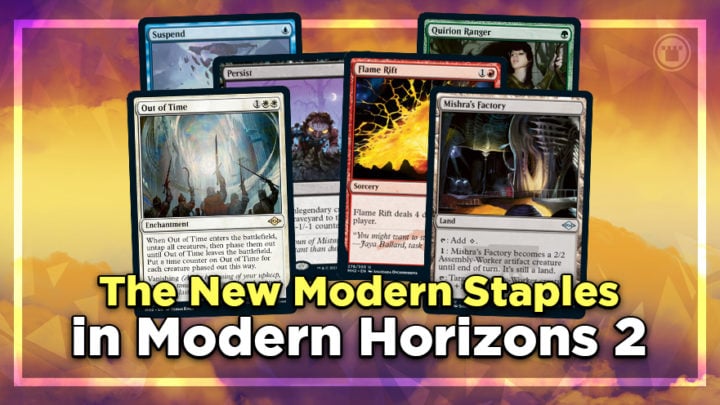Modern will never be the same again.
Just like its predecessor, Modern Horizons 2 is poised to leave a massive mark on Modern; many of the cards will see some level of play in the format, and even more will become Commander staples from day one. In my eyes, this is one of the most successful sets in the past few years. It’s going to be even more impactful than the first Modern Horizons, and likely in a very good way.
Today, I’ll take a look at one card from each color, a colorless card, and a land, and see where they might fit into Modern. I’ll talk about the cards and their uses, and explore potential homes for them.
White: Out of Time
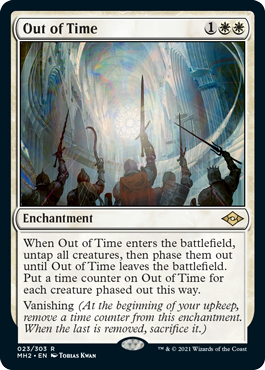
Phasing is an unusual effect that rarely appears in Magic anymore, and only really shows up where it’s relevant. This three-mana pseudo-board wipe is a fantastic use of the mechanic, and has a number of unique benefits that traditional board wipes can’t provide.
Any auras or equipment attached to creatures that are phased out go with them, meaning you can completely remove Sword of Feast and Famine or Batterskull, at least for some time. It also doesn’t target, so it will phase out any Slippery Bogle or Gladecover Scout you might encounter.
One huge benefit of Out of Time is using it against graveyard decks like Dredge; the creatures aren’t destroyed, so any Prized Amalgams or Bloodghasts your opponents summon will be locked out until the enchantment vanishes. This can be an enormous speed bump for them, and could give you enough time to stabilize against them.
Yorion, Sky Nomad works with Out of Time, too, albeit in an unusual way. Yorion can reset Out of Time, cleaning up any additional creatures since it was first cast, but they will also get phased out when it returns. That way, you can buy more time against an aggressive opponent, or even to protect your own board from a sweeper in a pinch. It’s important to note that creatures phasing back in don’t suffer from summoning sickness, so you can use your returned creatures to attack immediately.
This is an unusual card with a number of uses, and I expect to see it show up in any white deck that can take advantage of these interactions.
Blue: Suspend
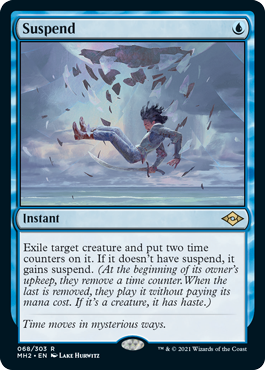
Blue has always been hurting for some effective removal, Dismember notwithstanding. Most of Commander’s premium blue removal (like Pongify or Reality Shift) is available in Modern already, but they perform significantly worse in formats with only one opponent and 20 life. Ravenform might have made the cut if it were an instant, but now Suspend is the card blue mages have been waiting for.
One mana for an instant is incredible, putting this on par with Path to Exile. While this doesn’t give your opponent a basic land, it does give them back their creature in two turns. This may seem like a huge downside, but two turns is an eternity in Modern. If things go well for you, your opponent will never see that creature again.
There are a number of potential homes for this spell. Firstly, Izzet Prowess could easily replace any copies of Vapor Snag with Suspend; this clears the way for one turn longer, and the deck is well-suited to capitalize on the opponent’s weakened defenses. Some players have been suggesting pairing this with slower decks that run Teferi, Time Raveler, as the passive ability prevents your opponent from casting spells on their upkeep (provided Teferi is still around when they lose the last time counter). This is a neat interaction, and is reminiscent of when players paired Teferi with Delay, but in reality, there are just better options available. Path to Exile is a better removal spell in the same colors, and doesn’t require you to protect a planeswalker for full impact.
Combo decks are likely to be the biggest benefactor of this spell. Temporarily getting rid of a Thalia, Guardian of Thraben or Eidolon of the Great Revel is often all that’s needed for Storm to win; it can also ease any pressure from Death’s Shadow or Scourge of the Skyclaves, giving you just enough breathing room to set up a combo turn.
Black: Persist

Do you think they’re worried about Griselbrand?
Between Unmarked Grave and Persist, it’s clear that there are two types of players in WotC R&D: Reanimator players, and people who fear Griselbrand. And rightly so: any time that Griselbrand is cheated into play quickly is either an immediate win or at least an immense uphill battle. This kind of gameplay is best left to the formats that can handle it, i.e. Legacy.
That doesn’t mean that Reanimator is a non-starter in Modern, though. Persist is exactly what the archetype needed: a cheap, powerful reanimation spell, but with enough drawbacks that you won’t be just getting a Griselbrand on turn 2. The restrictions on Persist aren’t even that restrictive, either, as there are countless incredible nonlegendary reanimation targets. Ashen Rider, Sundering Titan, Tidespout Tyrant, Rune-Scarred Demon, Blightsteel Colossus, and Platinum Emperion are all incredible choices that you can easily tutor for with Unmarked Grave.
Previous enablers like Gifts Ungiven and Unburial Rites weren’t good enough by themselves, but when played alongside this powerful new suite of spells, they bring additional redundancy and consistency to the deck. Alternatively, a Rakdos build could end up being more aggressively slanted, taking advantage of cards like Cathartic Reunion and Thoughtseize to force early answers. No matter which version ends up on top, this is one of the most exciting archetypes that’s being given the tools to stand among the titans of the Modern format. I can’t wait to raise hell with it.
Red: Flame Rift
Burn has been around since day one in Modern, and has undergone several permutations to remain relevant. Its presence as a powerful aggressive deck has been waning since the reign of Uro, Titan of Nature’s Wrath, however; I feel like it’s due for another metamorphosis soon, and Flame Rift may be the beginning.
Burn has been almost exclusively red-white since the printing of Skewer the Critics in Ravnica Allegiance, as the critical mass of powerful spells was enough to make any other splash either redundant or unnecessary. We may be on the way to dropping white altogether as well, and Flame Rift is the start of this change. Wayward Guide-Beast has been helping to work toward the mono-red dream, but we’ll probably still need something akin to Fireblast to make it worth going monocolor. With that said, Flame Rift will still have an impact in the meantime!
Burn can be a scary deck to pilot, particularly if you have an Eidolon of the Great Revel on board. You need to ensure that the symmetrical damage is worth the inherent risks, by doing more damage than you’re taking. Flame Rift occupies a similar role, so it likely won’t be an automatic playset, but there will be a balancing act between the two cards. I imagine these two will take up a total of six slots in the main deck; Eidolon will be a four-of with a pair of Flame Rifts if there’s a lot of combo, with the numbers reversed if the format is slower.
Some Death’s Shadow players have also suggested running a number of copies of Flame Rift in a hyper-aggressive Rakdos build, as it powers up both Shadow and Scourge of the Skyclaves while applying pressure. I can’t see it, personally, though I’m more used to seeing Death’s Shadow players being careful with their life totals. If the metagame calls for it, maybe they can afford to be a little less surgical.
No matter which side of the Burn and Death’s Shadow match-up you’re on, Flame Rift is important enough to burn a few dollars on a playset!
Green: Quirion Ranger
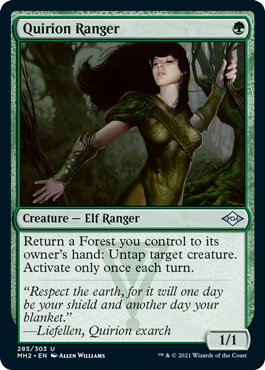
Most successful creature decks in Modern fall into one of two camps: disruptive aggro decks or combo decks. Humans, Taxes, and Spirits are the former; Heliod Company and B/G Yawgmoth sit in Camp Combo. Elves used to sit alongside their unfair counterparts as another great choice, but lack of support and the introduction of Plague Engineer led them to fade into the overgrowth of Llanowar. There was a recent resurgence thanks to Elvish Warmaster and Realmwalker, but they still needed that little bit more to be worth playing in a field full of Lava Darts.
Quirion Ranger might be exactly what Elves needed to come to the forefront as a deck that’s as strong as it is loved. The ability to untap any Elf you control by bouncing a Forest is an immense power; Elvish Archdruid is the ideal target, but even untapping a simple Llanowar Elves is a decent fail case.
You can keep a wider range of hands with Quirion Ranger, too, as one-land hands immediately become more powerful with them. You can play them with a Forest on turn one, and if you don’t draw a second land, you can tap the Forest for mana, bounce it to untap Quirion Ranger, then play the Forest as your land for the turn. This effectively gives you two mana from one land, and allows you to run fewer lands in general. You can even activate their ability on your opponent’s turn, too: you might look tapped out to your opponent, but you could untap an Elvish Archdruid and use the mana to cast a Collected Company before blocks are declared, which could be a massive blowout.
Even outside of Elves, budget decks like Mono-Green Stompy could take advantage of Quirion Ranger to pack more threats while lowering the land count. The Pauper Walls Combo deck is almost entirely Modern-legal now, and it could get enough new toys in this format’s larger card pool to become a real deck here, too. Respect the Elf, for it will one day be your enabler and another day your game loss.
Land: Mishra’s Factory
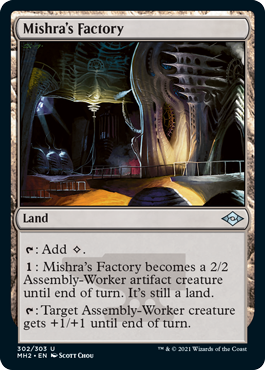
Assembly-Worker Tribal may have quite a way to go before it can stand among the likes of Humans or even Merfolk, but Mishra’s Factory is a great addition to Modern regardless.
Many people expected decks to run fewer lands as the Modern card pool grew, as only the cheapest and most efficient cards would make the cut. What most players didn’t anticipate is that a lot of decks are leaning toward slightly higher land counts where possible; this is partly due to the MDFC’s from Zendikar Rising, but mostly thanks to the additional utility available in lands like Blast Zone and the Triome cycle.
Mishra’s Factory may not seem like much at first, but it’s an extremely powerful creature land. Not only can it provide a decent clock in a pinch, but it’s also capable of pumping another Mishra’s Factory (or a changeling, like Mutavault). This is a direct upgrade from Mutavault in 8-Rack, and will likely show up in artifact decks like Whirza or Hardened Scales. Access to an artifact creature will prove instrumental in those decks, giving them additional options in their often complex decision trees.
Any decks in the market for a creature land that isn’t a tribal deck, and doesn’t have heavy mana requirements, should consider Mishra’s Factory. It may not look like much at first, but this is one factory that will produce great results.
***
There’s no denying the power of Modern Horizons, and there’s no doubt that it will define the format as a whole. Many archetypes are about to get the biggest boost they’ve seen in years, and I’m excited to see their power skyrocket. Some are claiming that the in-jokes and references in this set are making it feel like an Un-set, but I, for one, welcome our new Squirrel overlords.
What’s your favorite Modern Horizons 2 card? Do you have a pet deck that’s getting some sweet new tools? I’d love to hear about it, so be sure to let me know over on Twitter!

Scott is an Irish content creator and the Head of Budget Magic for the Izzet League. He focuses on affordable decks in Pioneer, Modern, and Pauper, particularly ones that stray from the mainstream. When he’s not writing about his favorite decks, he can be found talking incessantly about them on Twitter and on The Budget Magic Cast.

